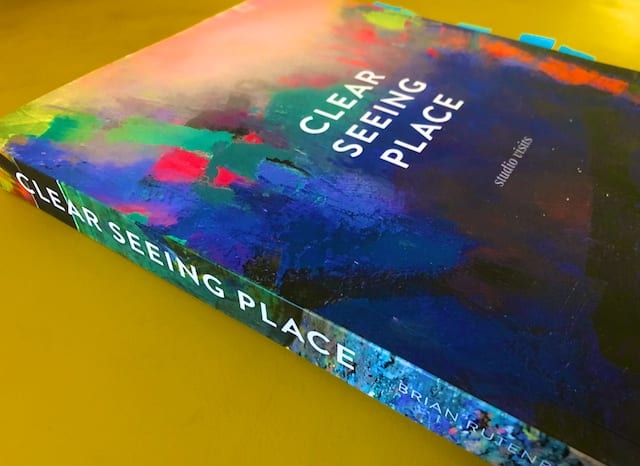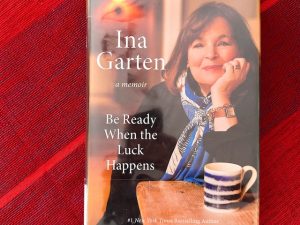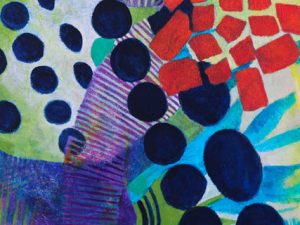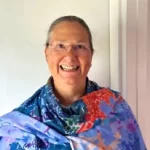
I loved this book and give it five stars. Brian Rutenburg was a featured artist on this blog back in 2014. I’ve loved his work for a long time. It was a complete pleasure to read this memoir of his, and enter into his studio and thoughts. Now I like the guy as well! He is kind to everyone, generous with his expertise, doesn’t have a huge ego, is grateful, loyal and loving towards his wife, and worked hard for what looked like his meteoric success.
You can also watch him on his YouTube channel, which I hadn’t known about until now; he’s been doing them monthly since 2010. Or you can follow him on instagram.
I tabbed a whole lot of what he has to say:
- “I’ve included a few trade secrets and bits of advice because, as a magician friend of mine once told me, if you want to keep something a secret, publish it.”
- “It’s easier to fall in love with your voice while no one’s listening. The worse thing a painter can do is edit while working. Spill everything out behind your locked door and fix it later. The time will come when you can unlock it, but for now, paint for an audience of one.”
- “I don’t want a painting to educate, shock or enlighten me; I want it to rip out my nervous system and replace it with someone else’s. I want to look into what the poet Mary Oliver calls ‘The white fire of a great mystery.'”
- “Painters don’t invite the viewer into a shared experience, they insist upon it. Subject matter is information, and the treatment of it generates content. How do you see the world? Let us stare through your eyes. Show us everything, and don’t leave anything out.”
- “Subject matter is the delivery system for empathy… Art is empathy, and it will save the world.”
- “Blue is thought to repel evil spirits, which is why porch ceilings down south are often painted the color of the sky.”
- “Mars black mixed with alizarin crimson makes a black cherry color, and when mixed with lemon yellow, produces a gorgeous dull green.”
- “The key to color is to try everything without scrutiny. Just play. You can’t think color; you have to see it… Some combinations work and others fail, but all it takes is one good decision and the entire painting hums. The secret it to pay attention.”
- “Abstraction is a process, not a style. Saying you’re painting abstracts is like saying you’re eating cooking: it doesn’t mean anything. To abstract means to remove, which implies it must be removed from something.”
- “What are you communicating? Sure, painting realistic water droplets on a chicken is impressive, but that’s not art. Some painters have a voice and lousy technique, while others have astounding facility but no soul; they’re just taking victor laps. Those who process both have molten lava. Be yourself– the rest is just constant practice.”
- “A painter must fall in madly in love with absolutely everything. The instant that work becomes labor, you’re dead.”
- “Urban life has taught me by necessity how to withdraw into myself on commands an electric eel generates voltage. Manhattan can be whatever you need: busy or lonely, rapid or glacially slow. I have the best family ever and plenty of friends, but I love to be alone and feel fortunate to have a career that demands solitude.”
- “Avid enthusiasm for interests other than painting is an integral part of my practice because through them I get to know myself better.”
- “I provide the close-up and the far away, and the viewer provides the middle. This is nothing new. The Canadian Group of Seven painters from the 1920s and 1930s eliminated middle ground in order to give the spectator the impression of being in direct proximity with the raw power of nature.”
- “Knowledge can make you formidable, but knowledge paired with permission makes you twelve feet tall and bulletproof.”
- “Art happens when the intellectual and the visceral collide so violently that they fuse into a third thing.”
- “A landscape painting is complete when the landscape vanishes.”
- “The best artists are also the nicest.”
- “I see color in words.”
- “Glenn Gould famously said, ‘ The purpose of art is the gradual, lifelong construction of a state of wonder and serenity.'”
- “Painters don’e die. They stand in the wind growing thinner and thinner until only the wind remains.”
- “All artists live in the gap between what they imagine and what they produce; no finished painting ever looks as good as the one I see in my mind, but the next one might.”
- “Tell me, which one is mightier: polished granite or the lucent wings of a butterfly.”
- “If it looks good, it is good. Authenticity is elastic. I will fully commit to anything that delivers a complex and enduring experience no matter if it is carved from ivory five centuries before or mass produced and covered with LED lights last week… Whatever makes you feel most like yourself is authentic.”
- “I know a painting is trying to hard when I can describe it.”
- “If I have a particular color combination in which I want the viewers to dwell, I use broken lines and fragmented colors to halt the eye and draw attention to those areas. I can get a similar effect by using contrasting hues, like bight purple and permanent green or cherry red and cobalt teal, which arrest the viewer’s gaze and give jim or her time to consider more subtle arrangements nearby.”
- “George Santayana wrote, ‘Beauty is the cooperation of pleasures, truth the cooperation of perceptions.'”
- “Paint from gratitude. Great art can arise from discontent and cynicism, but it can also be born of wonder and serenity. Speak from your heart.”
- Friedrich Nietzsche said, ‘The essence of all beautiful art, all great art, it gratitude.’
- “If you are focused on making art, it will end up looking like someone else’s. Your true job is to construct a clear seeing space.”
- “Keats taught me that life isn’t a support system for art, but the other way around. Art shows us how to be human. We move through life divided in half, focused on either thoughts or bodily sensations. Rarely are we fully present in both. Art teaches us to be whole because it is whole. A painting is two things at the same time: a flat surface with little piles of color and a fictive world into which we expand our consciousness… Every painter makes paint vanish.”
- “Each new brushstroke squeezes out an old one so that a finished painting is half-visible; the other half is the hushed vibration of absence.”
- “The best paintings are those you can’t describe moments after seeing them.”
- “If it doesn’t help, take it out. What’s the least amount of information your painting can have and be a painting?”
- “As Sickert advised, ‘Start like a bricklayer, finish like a jeweler’… Don’t analyze when you begin…Do first, think later… Let everything pour out, and then make corrections later.”
- “If I anticipate a warmer final painting, then I’ll underpaint in cooler tones like magenta, pale green, or cerulean blue, while a cooler picture gets a warm underpainting of burnt sienna, orange, or cadmium red deep.”
- Ray Bradbury: “Don’t think. Thinking is the enemy of creativity. It’s self conscious, and anything self conscious is lousy. You can’t try to do things. You simply must do things.”
- Otto Peterson: “I exaggerate to clarify.”
- “Practice to loose technique instead of acquire it. When the effortless appears difficult, it’s entertainment. When the difficult looks effortless, it’s art.”
- “Hue: is it warm or cool? Cerulean blue is warmer than ultramarine blue; alizarin crimson is cooler than cadmium red; lemon yellow is cooler than cadmium yellow bright.”
- Intensity: is it bright or dull? Tone/Value: Is it light or dark? The trick is being cognizant of value and intensity at the same time. Color straight from the tube is high intensity. Tinting with white will lighten the value but dull the intensity. Use white sparingly, especially at the beginning, as it can make color chalky and lifeless. Try substituting other opaque lights like flesh pink, Naples yellow, or royal blue for white.”
- Henri Matisse: “A thimbleful of red is redder than a bucketful.”
- Hans Hoffmann said, “In nature light creates color; in painting color creates light.”
- “For luminosity, for instance, begin with washes of transparant color mixed with Gamsol thinner over white gessoed canvas. After fifteen minutes, remove some of the wash with a clean rag. Wiping into transparant color is a gorgeous way to suggest glow. Conversely, adding layers of saturated opaque color will give a painting the appearance of being lit from within. To suggest light in a painting, you must also recognize the absence of it… shadows can be full of color and dimension.”
- “Is your painting about the light or the thing being lit?”
- “Squeeze one end of a water balloon, and the opposite end will bulge. This is a good way to think about pictorial space. Tension can’t exist without release. When I apply color, I ask, Is it squeezing or bulging?”
- “My medium of choice is three parts Galkyd and one part walnut oil. Walnut oil doesn’t yellow like linseed oil, but can go rancid if not refrigerated. I like to mix Galkyd and paint on a palette. Then I let it sit for ten minutes before scraping the semi-dried color up with a knife and applying it directly to the canvas. The resulting color has a sticky, skidding quality that arrests the eye.”
- “Glazing with opposites can also dull colors beautifully. For example, a purple wash over yellow paint will bend toward brown. Conversely, applying transparent glaze in the same hue, such as Indian yellow over cadmium yellow, perylene red over cadmium red deep, pthalo green over permanent green, or French ultramarine blue over cerulean blue, creates saturated blasts of color that leap off the canvas.”
- “Regardless of whether it is representational or abstract, if your viewer can identify and describe everything in your painting, then something’s wrong. An eye not told what to see sees more.”
- “The good stuff occurs in the transitions, and art magnifies them; a painting is a compressed version of an entire lifetime.”
- “Every painting I make taps into everything I’ve ever done, all the places I’ve been, and every person I’ve met along the way. The longer I paint, the richer the soil.”
- “Many painters claim that a title limits the viewer and undermines the purity of the image. I disagree. A painter must take a clear, personal stance without telling the viewer what to see, only how to see it.”
- “Having played drums for twenty years, I see and apply color percussively. Painting is rhythm made visible.”
- “I meet a lot of young and less-experienced painters, and the two most common mistakes they make are not leaving the brushstroke alone and harboring a fear of using thick paint.”
- “Life’s only commodity is time. How will you spend yours?”
- “All the talent in the world is meaningless without an atomic work ethic. An artist is someone who is willing to work harder than anyone in the room at stuff no one cares about.”
- “If you are goin to impinge on someone’s consciousness, even for a second, you have to grab them by the earlobes with a composition that looks good from twenty-five feet away.”
- “My primary representative is Forum Gallery, located at the corner of Fifth Avenue and Fifty-Seventh Street in New York City, the most visible and desirable retail corner on earth.”
- “If you feel a gallery shares your aesthetic, then go to their openings and introduce yourself.”
- “True success is curiosity and effort. Popularity is given and taken away by others, but curiosity and effort are yours alone.”
- “So lock your door and make your own clear seeing place. It’s easier than you think. I’ve told you how I did it. Now it’s your turn to do it better.”
I thought Clear Seeing Place was wonderful– definitely one of my best reads this year. I’m looking forward to watching more of Brian’s Youtube videos, and getting his more recent book A Little Long Time, which is illustrated with plates of his work. If you are interested in art, the lives of working artists, or even just memoirs, I think you’ll like it too.


4 Comments
-
Thanks so much for this, Polly! Love it!
-
I like Rutenberg’s shout out to the group of seven . Reading your excerpts is enough to make me want to read this book.
-
Just bought this, very enlightening! Thanks!
Pingbacks
-
[…] on this blog in 2014. Last year his memoir, Clear Seeing Space, was my favorite read of the year (see my review here).You can also watch him on his YouTube channel, which he’s been doing monthly since 2010. Or […]






